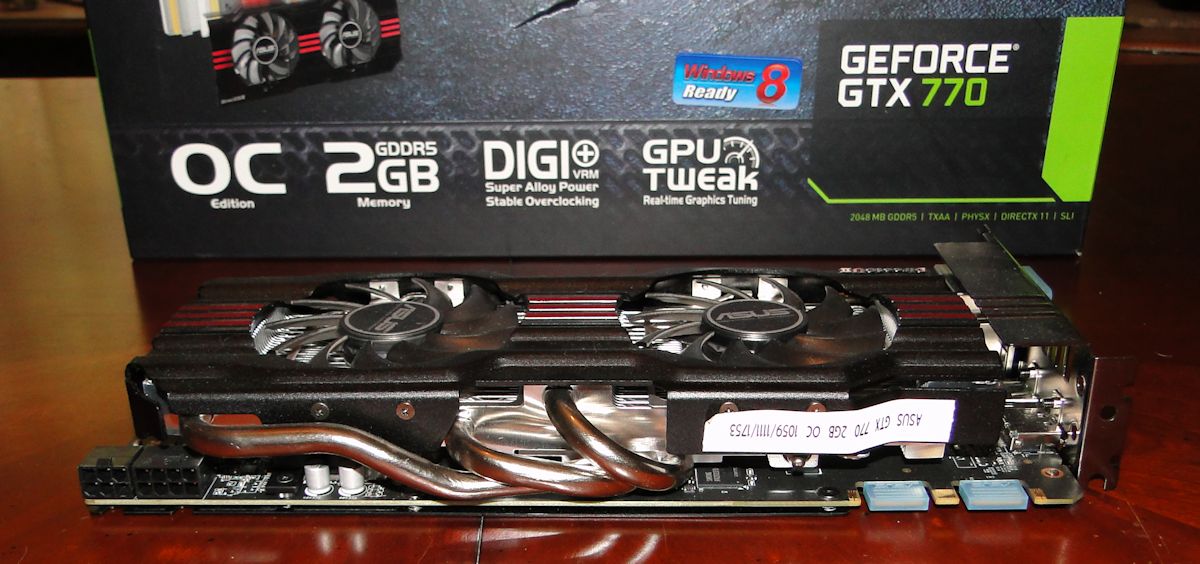ASUS GTX 770 DirectCU II OC
Oh GK104, how we love thee, let us count the ways. Oddly enough, we count three of the four boards being reviewed today utilizing this particular chip in multiple configurations. The GK104 first made its appearance in the GTX 670 and GTX 680 products last year. This refresh of the chip changes very little for the GTX 770. It still features the full 32 ROPs, 1536 CUDA Cores, and 128 texture units. The 256 bit memory bus addresses 2GB of GDDR-5 memory.
The only real thing that changes with the 770 over the previous 680 are the clock speeds. The core clock goes from 1006 MHz on the 680 to 1046 MHz on the 770. Boost goes from 1056 up to 1085. Asus improves upon these clockspeeds by taking the base clock to 1058 MHz and boost up to 1110 MHz. The memory clock gets a slight boost by hitting 7010 MHz effective instead of the reference 7000 MHz. This gives the Asus GTX 770 DCII approximately 224.32 GB/sec of bandwidth.
Overall the GTX 770 is a small boost over the previous GTX 680. The biggest change really is the price of the unit. The GTX 770 outperforms the previous GTX 680, but it is being offered at an initial $400 price point. ASUS does give this particular product their usual treatment.
It wouldn't be my house if there wasn't dust!
The heatsink and fan are decidedly from the last generation of DCII parts when it comes to looks. It does not feature the more complex/rounded/organic shroud as the GTX 780 DCII features. As mentioned before, ASUS has dropped the triple slot setup for the latest GTX 700 series of high end cards. This is a big positive for the product lineup. While the triple slots did very nicely with cooling, it was a pain to have such large cards in residence in a case. Going with a multi-GPU setup was also challenging with triple slot cards. The card features two 80 mm fans that are of the older variety rather than the newer CoolTech fan featured on the GTX 780. The heatsink features five heatpipes, two of which are 8 mm units. This card also does not include the new 10 mm heatpipe.
ASUS has given this board all of the same features in terms of construction as the GTX 780. It is a custom PCB with 10 total power phases (8 GPU, 2 memory). It utilizes the Super Alloy components. It has the Digi+ VRM functionality. This all is again aimed at higher efficiency, better overclocking performance, and better thermals all around.
It is somewhat unfortunate the ASUS did not include the new cooler/shroud designs with the inclusion of the CoolTech fan, but it seems that this design was finalized before the new DCII units were available. This does not make the board any less impressive though. It does come slightly overclocked out of the box, and the board promises to be an able performer when it comes to cranking those clocks up.
Yet another sweet, sweet backplate. The power plugs actually feature LEDs under them that will let a user know if something is wrong with the power. Unless the power is off…
While ASUS has done a nice job with this card, it is still essentially a slightly hopped up refresh of last year’s GTX 680. Thank goodness that it is being offered for much less than what the original 680 was going for back then.











The fact that every card has
The fact that every card has a new cooler except for the GTX 770 really irritates me…
It is a new cooler on the GTX
It is a new cooler on the GTX 770, because the previous GTX 680 had the triple slot number. It is unfortunate that they did not update the shroud though to match those of the 780 and 760.
Great cards these GTX780
Great cards these GTX780 Direct CUs. I’ve been a little hasty on getting the MSI GTX690 reference card early this March (got a great discount on it though 🙂 . It’s not overclocked (for acoustic and temperature reasons), but on a 60Hz 1080p SAMSUNG monitor displays everything beautifully, with all eye-candy maxed out. Constant 60FPS with V-Sync on for great image quality – that is on every game I played so far. No need for overclocking yet! If I hadn’t bought this GTX690 beauty, I most definitely would have gone for ASUS’s GTX780. Thanks for this review, Josh. Great job. All the best!
PS: Might wanna check Min/Avg colour bars on Unigine Heaven benchmarks page.
I had just gotten one of
I had just gotten one of these card myself and I have had problems with it. It goes unresponsive. As soon as I put back in my gtx 680 no problems so i was wondering whether it was the card so i wend and returned it and the next one did the same thing. So I had my friend let me borrow his GTX 770 this was a EVGA version I put that thing in and I had absolutely no problems what soever so keep this in mind.